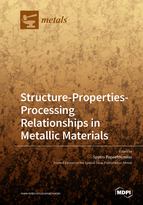Structure-Properties-Processing Relationships in Metallic Materials
A special issue of Metals (ISSN 2075-4701). This special issue belongs to the section "Metal Failure Analysis".
Deadline for manuscript submissions: closed (30 September 2021) | Viewed by 18020
Special Issue Editor
Interests: advanced materials; forming; welding; manufacturing; computational materials engineering; industrial processes
Special Issues, Collections and Topics in MDPI journals
Special Issue Information
Dear Colleagues,
The steady innovation of the steel industry in the last three decades has been accompanied by the introduction of simulation and analytical technique tools in the materials development chain. The necessity for increased efficiency and power and low emissions and, in parallel, safety, has brought forth new advanced high and ultra-high strength multiphase steel grades into the game of the automotive industry, one of the most competitive sectors in the world. Currently, even stricter rules for vehicle emissions forces a broader usage of light-weight metals and alloys with the main candidate being aluminum, but also magnesium. Also, the need for electrification paves the way for broad utilization of electrical steels and copper alloys.
The microstructure analysis, the physical and the numerical simulation tools alone could not explain the penetration of new advanced high-strength steel grades into our everyday life. The process development of complex continuous annealing lines has served the thirst for complex thermal processing and heat treatment cycles, which in turn have made the commercialization of dual phase, TRIP, complex phase, and other advanced high-strength steel grades possible.
At present, the 4th-generation AHSS are on the doorstep of commercialization and seek their path into automotive production, where steel currently faces stiffer competition from aluminum. Quenching and partitioning and medium manganese steels are very promising candidates for high-strength body-in-white applications where thin sheets are still in high demand. Furthermore, rapid heating or ultra-fast processing may provide an alternative route with lean alloying and in cases where tubes or other structural parts, also sheets, can be utilized.
The microstructure–properties relationships in combination with processing or alloying strategies for the development of tailored microstructures and, thus, also mechanical properties, in new steels grades have been throughout the years intensively investigated by academia and industry. Simulation approaches for addressing not only diffusional, but also shear and displacive transformations are now of great interest for the process simulation and control of the microstructure evolution, taking into consideration processing conditions and/or limitations. Additionally, electrical steels and the need for texture oriented rolling, the aluminum with tailored rolling and heat treatments for aging characteristics underline the necessity for proper structure-properties-processing control.
In the current Special Issue of Metals, we cordially invite all researchers from academia and the steel industry to submit their opinions, their latest research developments, and achievements in this field. Our aim is to shed more light into the fascinating world of advanced high-strength steels, aluminum, copper and other lightweight materials for automotive applications including electrical steels for electrification needs. Works that focus on physical metallurgy, new characterization techniques, microstructure–properties relationships, and also on the significant scientific and technical challenges of simulation studies, both physical and numerical, are especially encouraged.
Our aim is to bridge academia and industry, providing the needed theoretical aspects for advanced applications in the automotive industry under the prism of microstructure–properties–processing relationships incorporating simulation (both numerical and physical) that can serve the purpose of optimization of new materials to be applied and/or concepts and novel aspects of current or new to-be-adopted steel grades. This Special Issue will encompass all of these areas, giving a broad spectrum that explains the complexity of the research and development of new advanced high-strength steel grades that are superior to other available materials (in thin sheets and other structural forms) for such applications.
Prof. Dr. Spyros PapaefthymiouGuest Editor
Manuscript Submission Information
Manuscripts should be submitted online at www.mdpi.com by registering and logging in to this website. Once you are registered, click here to go to the submission form. Manuscripts can be submitted until the deadline. All submissions that pass pre-check are peer-reviewed. Accepted papers will be published continuously in the journal (as soon as accepted) and will be listed together on the special issue website. Research articles, review articles as well as short communications are invited. For planned papers, a title and short abstract (about 100 words) can be sent to the Editorial Office for announcement on this website.
Submitted manuscripts should not have been published previously, nor be under consideration for publication elsewhere (except conference proceedings papers). All manuscripts are thoroughly refereed through a single-blind peer-review process. A guide for authors and other relevant information for submission of manuscripts is available on the Instructions for Authors page. Metals is an international peer-reviewed open access monthly journal published by MDPI.
Please visit the Instructions for Authors page before submitting a manuscript. The Article Processing Charge (APC) for publication in this open access journal is 2600 CHF (Swiss Francs). Submitted papers should be well formatted and use good English. Authors may use MDPI's English editing service prior to publication or during author revisions.
Keywords
- Advanced high strength steels
- DP/TRIP/TWIP steels
- Medium manganese steels
- Quenching and partitioning steels
- Ultra-fast processed steels
- Aluminum alloys for automotive applications
- Magnesium alloys for automotive solutions
- Electrical steels for electrified automobiles
- Mechanical properties
- Microstructural characterization
- Process and microstructure optimization
- Process simulation
- Microstructure modeling
- Physical and numerical simulations
- Finite element analysis






